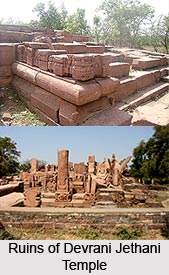 Devrani and Jethani temple is located in Chhattisgarh in Tala. The temples, adjacent to each other, owe their names to their dimensions. The somewhat larger one was christened Jethani (elder sister-in-law) by the villagers while the smaller one came to be known as Devrani.
Devrani and Jethani temple is located in Chhattisgarh in Tala. The temples, adjacent to each other, owe their names to their dimensions. The somewhat larger one was christened Jethani (elder sister-in-law) by the villagers while the smaller one came to be known as Devrani.
Devrani Temple
Devrani temple is the smaller one which is dedicated to Lord Shiva. The temple faces the east direction. The river Maniyari flows on the back side of the temple.
The size of the temple is 75x32 feet and has an exceptional ground plan. It consists of a Garbhagriha, antarala, and narrow mukhmandapa preceded by an open space, approach 1ed by a flight of steps with a large chandra shila.
The mukhamandapa has a beautiful doorway, depicting river goddess on the bottom part of the door jamb. On the lalatbimba Gajalakshmi is shown in bold relief. The bhitti part rises up to a height of 10 feet but the sikhara is missing.
The temple site has yielded a variety of sculptures including different gods and goddess of Hindu pantheon, Demi gods, animals, mythical figures, with floral depictions and a variety of geometrical and non geometrical motifs. Among them one sculpture is most important and perhaps the only one of its kind in the world which is addressed as Rudra Shiva. This is a monolithic gigantic sculpture of 2.70 metres height, two armed and in standing posture. It has unusual iconographic features depicting various animals along with human and lion heads as body components. A turban is made of a pair of snakes. The serpent is probably a favourite depiction of the artist. Therefore, the waists, hand and finger nails are also designed like snakes. Apart from this, a pair of serpent hood figures on either side of tile head above shoulders. A snake is also shown entwining the left legs. Among other animals peacock is depicted as ornamenting ears. Eye brows and nose are made of lizards. Chin is shaped like a Crab. Both the shoulders have depiction of crocodiles. Seven human heads are engraved in various parts of the body. Because of the unusual depiction mentioned above, identification of this sculpture is still a matter of debate among the scholars. Stylistically all the archaeological remains at Tala are datable to first half of sixth century A.D.
Jethani Temple
Jethani Temple faces south direction and is dedicated to Lord Shiva. Although it is partially exposed, the ground plan of the temple is clearly visible. It consists of a sanctum and a Mandapa in front. It has entrances from three sides i.e., south, east and west. The main entrance of the temple could be approached through a wide flight of steps. In the surrounding area shafts of the massive pillars are lying scattered and decorated with different types of motifs. The basal part of the pillar is designed with kumbhas. The upper part of the pillar consists of a convex-lobbed amalaka resting upon a vase, decorated with festoons hanging from lion`s mouth. Sanctum part is much damaged and no traces of the superstructure are available. Gaja-Mukha or Dikpalas are visible in basement. This site is a precious Cultural Heritage of the world and is worthy to be included in the list of World Heritage.











